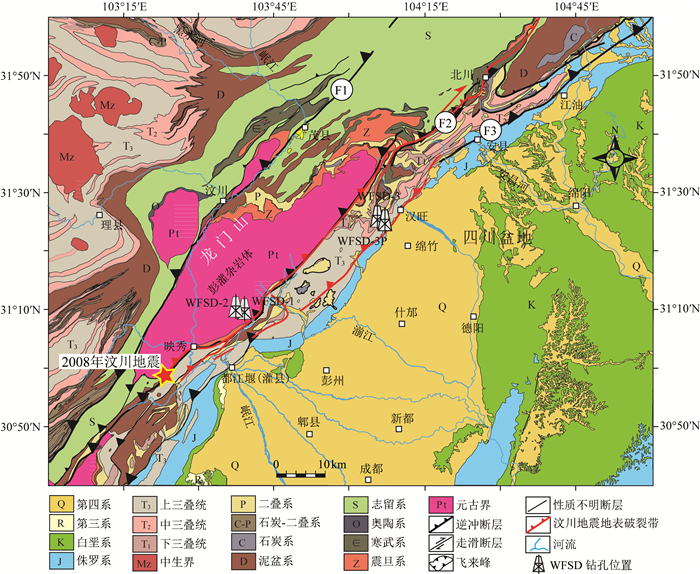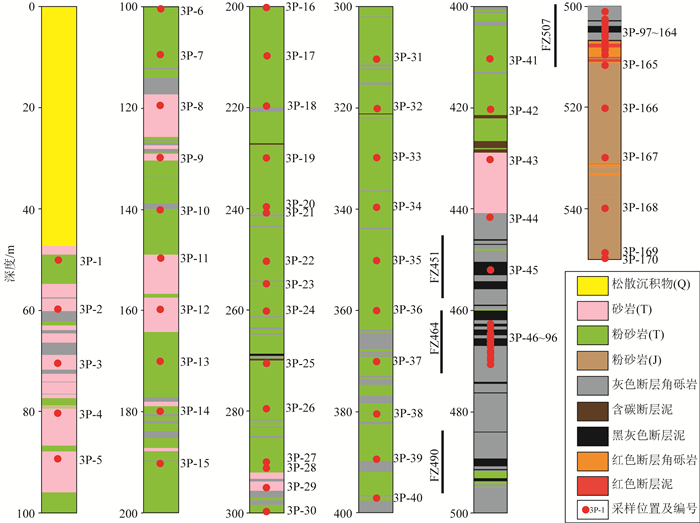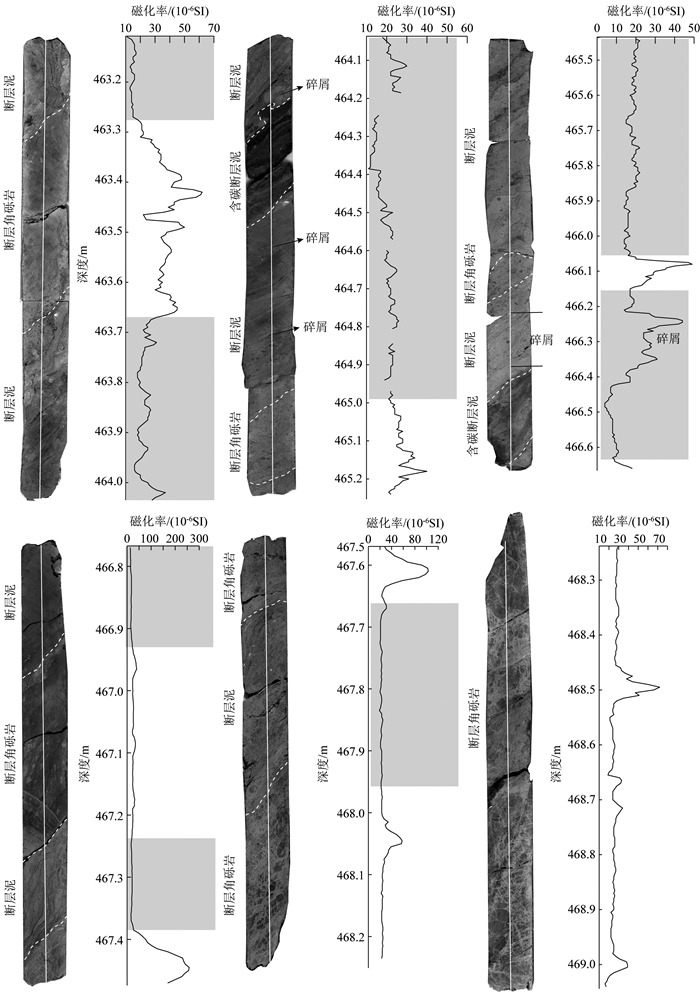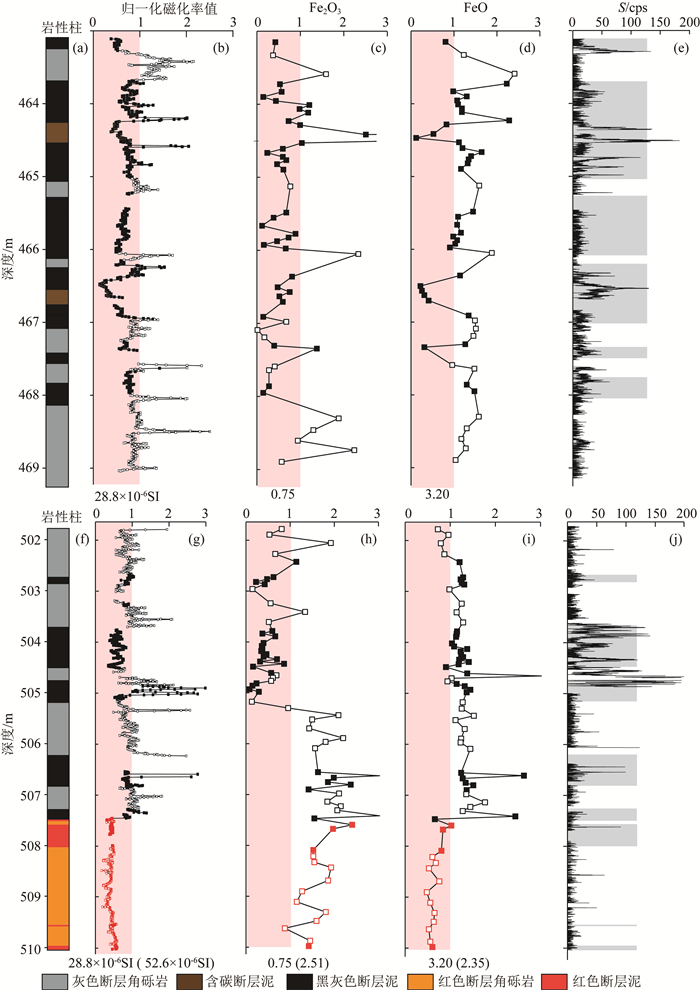|
Aringhieri R.
2004. Nanoporosity characteristics of some natural clay minerals and soils. Clays and Clay Minerals, 52(6): 700-704.
DOI:10.1346/CCMN.2004.0520604 |
|
|
Aubourg C, Pozzi J P.
2010. Toward a new < 250 ℃ pyrrhotite-magnetite geothermometer for claystones. Earth and Planetary Science Letters, 294(1-2): 47-57.
DOI:10.1016/j.epsl.2010.02.045 |
|
|
Cairanne G, Aubourg C, Pozzi J P, et al.
2004. Laboratory chemical remanent magnetization in a natural claystone: a record of two magnetic polarities. Geophysical Journal International, 159(3): 909-916.
DOI:10.1111/gji.2004.159.issue-3 |
|
|
Chang S H, Wang W H, Lee J C.
2009. Modelling temporal variation of surface creep on the Chihshang fault in eastern Taiwan with velocity-strengthening friction. Geophysical Journal International, 176(2): 601-613.
DOI:10.1111/gji.2008.176.issue-2 |
|
|
Chen K H, Bürgmann R.
2017. Creeping faults: good news, bad news?. Reviews of Geophysics, 55(2): 282-286.
DOI:10.1002/rog.v55.2 |
|
|
Chou Y M, Song S R, Aubourg C, et al.
2012a. Pyrite alteration and neoformed magnetic minerals in the fault zone of the Chi-Chi earthquake ( MW7.6, 1999): Evidence for frictional heating and co-seismic fluids. Geochemistry, Geophysics, Geosystems, 13(8): Q08002.
DOI:10.1029/2012GC004120 |
|
|
Chou Y M, Song S R, Aubourg C, et al.
2012b. An earthquake slip zone is a magnetic recorder. Geology, 40(6): 551-554.
DOI:10.1130/G32864.1 |
|
|
Densmore A L, Ellis M A, Li Y, et al.
2007. Active tectonics of the Beichuan and Pengguan faults at the eastern margin of the Tibetan Plateau. Tectonics, 26(4): TC4005.
DOI:10.1029/2006TC001987 |
|
|
Fisher Q J, Knipe R J.
2001. The permeability of faults within siliciclastic petroleum reservoirs of the north sea and norwegian continental shelf. Marine and Petroleum Geology, 18(10): 1063-1081.
DOI:10.1016/S0264-8172(01)00042-3 |
|
|
Fu B H, Shi P L, Guo H D, et al.
2011. Surface deformation related to the 2008 Wenchuan earthquake, and mountain building of the Longmen shan, eastern Tibetan Plateau. Journal of Asian Earth Sciences, 40(4): 805-824.
DOI:10.1016/j.jseaes.2010.11.011 |
|
|
Gillett S L.
2003. Paleomagnetism of the Notch Peak contact metamorphic aureole, revisited: pyrrhotite from magnetite+pyrite under submetamorphic conditions. Journal of Geophysical Research, 108(B9): 2446.
DOI:10.1029/2002JB002386 |
|
|
Goddard J V, Evans J P.
1995. Chemical changes and fluid-rock interaction in faults of crystalline thrust sheets, northwestern Wyoming, U.S.A. Journal of Structural Geology, 17(4): 533-547.
DOI:10.1016/0191-8141(94)00068-B |
|
|
Goldstein A G, Brown L L.
1988. Magnetic susceptibility anisotropy of mylonites from the Brevard Zone, North Carolina, U.S.A. Physics of the Earth and Planetary Interiors, 51(4): 290-300.
DOI:10.1016/0031-9201(88)90070-2 |
|
|
Gratier J P, Thouvenot F, Jenatton L, et al.
2013. Geological control of the partitioning between seismic and aseismic sliding behaviours in active faults: Evidence from the Western Alps, France. Tectonophysics, 600: 226-242.
DOI:10.1016/j.tecto.2013.02.013 |
|
|
Grosz S, Matthews A, Ilani S, et al.
2006. Iron mineralization and dolomitization in the Paran Fault zone, Israel: Implications for low-temperature basinal fluid processes near the Dead Sea Transform. Geofluids, 6(2): 137-153.
DOI:10.1111/gfl.2006.6.issue-2 |
|
|
Guichet X, Jouniaux L, Catel N.
2006. Modification of streaming potential by precipitation of calcite in a sand-water system: Laboratory measurements in the pH range from 4 to 12. Geophysical Journal International, 166(1): 445-460.
DOI:10.1111/gji.2006.166.issue-1 |
|
|
Harris R A.
2017. Large earthquakes and creeping faults. Reviews of Geophysics, 55(1): 169-198.
DOI:10.1002/rog.v55.1 |
|
|
He X L, Li H B, Wang H, et al.
2018. Creeping Guanxian-Anxian fault ruptured during the 2008 MW7.9 Wenchuan earthquake in the Longmen Shan thrust belt, China. Tectonics.
|
|
|
Hirono T, Lin W, Yeh E C, et al.
2006. High magnetic susceptibility of fault gouge within Taiwan Chelungpu fault: nondestructive continuous measurements of physical and chemical properties in fault rocks recovered from Hole B, TCDP. Geophysical Research Letters, 33(15): L15303.
DOI:10.1029/2006GL026133 |
|
|
Hounslow M W, Morton A C.
2004. Evaluation of sediment provenance using magnetic mineral inclusions in clastic silicates: Comparison with heavy mineral analysis. Sedimentary Geology, 171(1-4): 13-36.
DOI:10.1016/j.sedgeo.2004.05.008 |
|
|
Ishikawa T, Tanimizu M, Nagaishi K, et al.
2008. Coseismic fluid-rock interactions at high temperatures in the chelungpu fault. Nature Geoscience, 1(10): 679-683.
DOI:10.1038/ngeo308 |
|
|
Jolivet R, Candela T, Lasserre C, et al.
2015. The burst-like behavior of aseismic slip on a rough fault: the creeping section of the Haiyuan fault, China. Bulletin of the Seismological Society of America, 105(1): 480-488.
DOI:10.1785/0120140237 |
|
|
Kapička A, Hoffmann V, Petrovskč E.
2003. Pressure instability of magnetic susceptibility of pyrrhotite bearing rocks from the KTB borehole. Studia Geophysica et Geodaetica, 47(2): 381-391.
DOI:10.1023/A:1023731910247 |
|
|
Kuo L W, Song S R, Yeh E C, et al.
2012. Clay mineralogy and geochemistry investigations in the host rocks of the Chelungpu fault, Taiwan: Implication for faulting mechanism. Journal of Asian Earth Sciences, 59: 208-218.
DOI:10.1016/j.jseaes.2012.07.009 |
|
|
Lang Y Q, Hu D Q, Liu C, et al.
2011. Mineralogy study of magnetic susceptibility of rocks along the coast of the northern South China Sea. Chinese Journal of Geophysics, 54(2): 573-587.
DOI:10.3969/j.issn.0001-5733.2011.02.037 |
|
|
|
|
|
Li H B, Wang H, Xu Z Q, et al.
2013. Characteristics of the fault-related rocks, fault zones and the principal slip zone in the Wenchuan Earthquake Fault Scientific Drilling Project Hole-1 (WFSD-1). Tectonophysics, 584: 23-42.
DOI:10.1016/j.tecto.2012.08.021 |
|
|
Li H B, Wang H, Yang G, et al.
2016. Lithological and structural characterization of the Longmen Shan fault belt from the 3rd hole of the Wenchuan Earthquake Fault Scientific Drilling project (WFSD-3). International Journal of Earth Sciences, 105(8): 2253-2272.
DOI:10.1007/s00531-015-1285-9 |
|
|
Li H B, Xu Z Q, Wang H, et al.
2018. Fault behavior, physical properties and seismic activity of the Wenchuan earthquake fault zone: evidence from the Wenchuan earthquake Fault Scientific Drilling project (WFSD). Chinese J. Geophys., 61(5): -.
DOI:10.6038/cjg2018M0257 |
|
|
Li H Y, Zhang S H.
2005. Detection of mineralogical changes in pyrite using measurements of temperature-dependence susceptibilities. Chinese Journal of Geophysics, 48(6): 1454-1461.
DOI:10.1002/cjg2.794 |
|
|
Li Y, Zhou R J, Densmore A L, et al.
2006. Geomorphic evidence for the late Cenozoic strike-slipping and thrusting in Longmen Mountain at the eastern margin of the Tibetan Plateau. Quaternary Sciences, 26(1): 40-51.
|
|
|
Liu D L, Li H B, Lee T Q, et al.
2014. Primary rock magnetism for the Wenchuan earthquake fault zone at Jiulong outcrop, Sichuan Province, China. Tectonophysics, 619-620: 58-69.
DOI:10.1016/j.tecto.2013.08.028 |
|
|
Liu D L, Li H B, Lee T Q, et al.
2016. Magnetic mineral characterization close to the Yingxiu-Beichuan fault surface rupture zone of the Wenchuan earthquake ( MW7.9, 2008) and its implication for earthquake slip processes. Journal of Asian Earth Sciences, 115: 468-479.
DOI:10.1016/j.jseaes.2015.10.019 |
|
|
Liu D L, Li H B, Li D G, et al.
2015. Fault-rock magnetism from the earth surface trench reveals the different slip dynamics of the Wenchuan earthquake surface rupture zone. Acta Geologica Sinica, 89(12): 2250-2265.
|
|
|
|
|
|
Liu Q S, Deng C L, Pan Y X.
2007. Temperature-dependency and frequency-dependency of magnetic susceptibility of magnetite and maghemite and their significance for environmental magnetism. Quaternary Sciences, 27(6): 955-962.
|
|
|
Liu T Y. 2007.
Conspectus of Geophysical Exploration. Beijing: Geological Publishing House.
|
|
|
Liu-Zeng J, Zhang Z, Wen L, et al.
2009. Co-seismic ruptures of the 12 May 2008, MS8.0 Wenchuan earthquake, Sichuan: East-west crustal shortening on oblique, parallel thrusts along the eastern edge of Tibet. Earth and Planetary Science Letters, 286(3-4): 355-370.
DOI:10.1016/j.epsl.2009.07.017 |
|
|
|
|
|
Maurer J, Johnson K.
2014. Fault coupling and potential for earthquakes on the creeping section of the central San Andreas Fault. Journal of Geophysical Research: Solid Earth, 119(5): 4414-4428.
DOI:10.1002/2013JB010741 |
|
|
Mishima T, Hirono T, Nakamura N, et al.
2009. Changes to magnetic minerals caused by frictional heating during the 1999 Taiwan Chi-Chi earthquake. Earth Planets Space, 61(6): 797-801.
DOI:10.1186/BF03353185 |
|
|
Mishima T, Hirono T, Soh W, et al.
2006. Thermal history estimation of the Taiwan Chelungpu fault using rock-magnetic methods. Geophysical Research Letters, 33(23): L23311.
DOI:10.1029/2006GL028088 |
|
|
Moreau M G, Ader M, Enkin R J.
2005. The magnetization of clay-rich rocks in sedimentary basins: low-temperature experimental formation of magnetic carriers in natural samples. Earth and Planetary Science Letters, 230(1-2): 193-210.
DOI:10.1016/j.epsl.2004.11.013 |
|
|
Niwa M, Mizuochi Y, Tanase A.
2015. Changes in chemical composition caused by water-rock interactions across a strike-slip fault zone: Case study of the Atera Fault, Central Japan. Geofluids, 15(3): 387-409.
DOI:10.1111/gfl.12096 |
|
|
Noda H, Lapusta N.
2013. Stable creeping fault segments can become destructive as a result of dynamic weakening. Nature, 493(7433): 518-521.
DOI:10.1038/nature11703 |
|
|
Orlický O.
1990. Detection of magnetic carriers in rocks: Results of susceptibility changes in powdered rock samples induced by temperature. Physics of the Earth and Planetary Interiors, 63(1-2): 66-70.
DOI:10.1016/0031-9201(90)90060-B |
|
|
Pan Y X, Zhu R X, Banerjee S K, et al.
2000. Rock magnetic properties related to thermal treatment of siderite: behavior and interpretation. Journal of Geophysical Research: Solid Earth, 105(B1): 783-794.
DOI:10.1029/1999JB900358 |
|
|
Pei J L, Li H B, Sun Z M, et al.
2010. Fault slip in the Wenchuan earthquake fault zone information from fault rocks with higher magnetic susceptibility. Quaternary Sciences, 30(4): 759-767.
|
|
|
Pei J L, Li H B, Wang H, et al.
2014a. Magnetic properties of the Wenchuan earthquake fault scientific drilling project Hole-1 (WFSD-1), Sichuan Province, China. Earth, Planets and Space, 66(1): 23.
DOI:10.1186/1880-5981-66-23 |
|
|
Pei J L, Zhou Z Z, Dong S G, et al.
2014b. Magnetic evidence revealing frictional heating from fault rocks in granites. Tectonophysics, 637: 207-217.
DOI:10.1016/j.tecto.2014.10.008 |
|
|
|
|
|
Schill E, Appel E, Gautam P.
2002. Towards pyrrhotite/magnetite geothermometry in low-grade metamorphic carbonates of the Tethyan Himalayas (Shiar Khola, Central Nepal). Journal of Asian Earth Sciences, 20(3): 195-201.
DOI:10.1016/S1367-9120(01)00022-0 |
|
|
Sichuan Bureau of Geology and Mineral Resources. 1996. Geologic Map of Mianzhu (Scale 1: 50000) (in Chinese).
|
|
|
Tanikawa W, Mishima T, Hirono T, et al.
2007. High magnetic susceptibility produced in high-velocity frictional tests on core samples from the Chelungpu fault in Taiwan. Geophysical Research Letters, 34(5): L15304.
DOI:10.1029/2007GL030783 |
|
|
Tanikawa W, Mishima T, Hirono T, et al.
2008. High magnetic susceptibility produced by thermal decomposition of core samples from the Chelungpu fault in Taiwan. Earth and Planetary Science Letters, 272(1-2): 372-381.
DOI:10.1016/j.epsl.2008.05.002 |
|
|
Tembe S, Lockner D A, Wong T F.
2010. Effect of clay content and mineralogy on frictional sliding behavior of simulated gouges: Binary and ternary mixtures of quartz, illite, and montmorillonite. Journal of Geophysical Research Solid Earth, 115(B3): B03416.
DOI:10.1029/2009JB006383 |
|
|
Wang H, Li H B, Janssen C, et al.
2015. Multiple generations of pseudotachylyte in the Wenchuan fault zone and their implications for coseismic weakening. Journal of Structural Geology, 74: 159-171.
DOI:10.1016/j.jsg.2015.03.007 |
|
|
Xu H J, Jin Z M, Mason R.
2009a. Magnetic susceptibility of ultrahigh pressure eclogite: The role of retrogression. Tectonophysics, 475(2): 279-290.
DOI:10.1016/j.tecto.2009.03.020 |
|
|
Xu X W, Wen X Z, Yu G H, et al.
2009b. Coseismic reverse-and oblique-slip surface faulting generated by the 2008 MW7.9 Wenchuan earthquake, China. Geology, 37(6): 515-518.
DOI:10.1130/G25462A.1 |
|
|
Yamaguchi A, Cox S F, Kimura G, et al.
2011. Dynamic changes in fluid redox state associated with episodic fault rupture along a megasplay fault in a subduction zone. Earth and Planetary Science Letters, 302(3-4): 369-377.
DOI:10.1016/j.epsl.2010.12.029 |
|
|
Yang T, Chen J Y, Wang H Q, et al.
2012a. Magnetic properties of fault rocks from the Yingxiu-Beichuan fault: Constraints on temperature rise within the shallow slip zone during the 2008 Wenchuan earthquake and their implications. Journal of Asian Earth Sciences, 50: 52-60.
DOI:10.1016/j.jseaes.2012.01.013 |
|
|
Yang T, Chen J Y, Wang H Q, et al.
2012b. Rock magnetic properties of fault rocks from the rupture of the 2008 Wenchuan earthquake, China and their implications: preliminary results from the Zhaojiagou outcrop, Beichuan county (Sichuan). Tectonophysics, 530-531: 331-341.
DOI:10.1016/j.tecto.2012.01.019 |
|
|
Yang T, Chen J Y, Yang X S, et al.
2013. Differences in magnetic properties of fragments and matrix of breccias from the rupture of the 2008 Wenchuan earthquake, China: Relationship to faulting. Tectonophysics, 601: 112-124.
DOI:10.1016/j.tecto.2013.05.002 |
|
|
Yang T, Yang X S, Duan Q B, et al.
2016. Rock magnetic expression of fluid infiltration in the Yingxiu-Beichuan fault (Longmen Shan thrust belt, China). Geochemistry, Geophysics, Geosystems, 17(3): 1065-1085.
DOI:10.1002/2015GC006095 |
|
|
Zhang C, Wang Y, Liu Y, et al.
2013. Mineralogical study of magnetic susceptibility of intrusive rocks in the eastern Tibetan. Acta Mineralogica Sinica(S2): 868-869.
|
|
|
Zhang L, Sun Z M, Li H B, et al.
2017. Magnetic susceptibility of WFSD-2 borehole cores from the Longmenshan thrust belt and its implications for great seismic activity. Chinese Journal of Geophysics, 60(1): 225-239.
DOI:10.6038/cjg20170119 |
|
|
Zhang L, Sun Z M, Li H B, et al.
2017. Rock record and magnetic response to large earthquakes within Wenchuan Earthquake Fault Scientific Drilling cores. Geochemistry, Geophysics, Geosystems, 18(5): 1889-1906.
DOI:10.1002/ggge.v18.5 |
|
|
Zhang P Z, Wen X Z, Shen Z K, et al.
2010. Oblique, high-angle, listric-reverse faulting and associated development of strain: the Wenchuan earthquake of May 12, 2008, Sichuan, China. Annual Review of Earth and Planetary Sciences, 38(1): 353-382.
DOI:10.1146/annurev-earth-040809-152602 |
|
|
Zhang X L.
1991. The magnetic susceptibility, iron and magnetite content of Precambrian rocks in Finland. Foreign Geoexploration Technology(9): 22.
|
|
|
|
|
|
|
|
|
|
|
|
|
|
|
|
|
|
|
|
|
|
|
|
|
|
|
刘天佑. 2007.
地球物理勘探概论. 北京: 地质出版社.
|
|
|
|
|
|
|
|
|
四川省地矿局. 1996. 绵竹幅地质图(1: 50000).
|
|
|
|
|
|
|
|
|
|
|
 2018, Vol. 61
2018, Vol. 61










